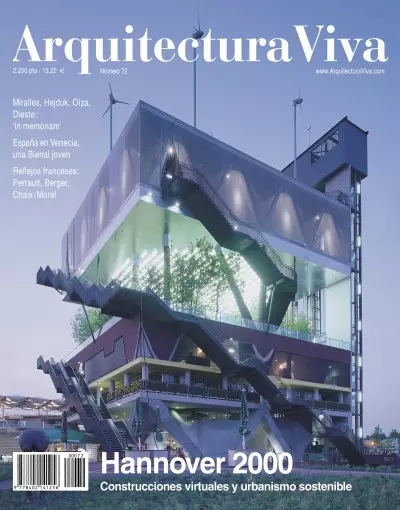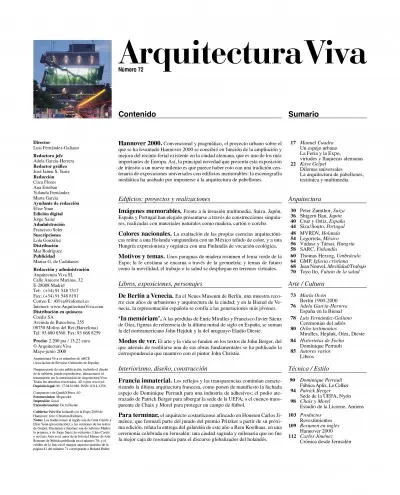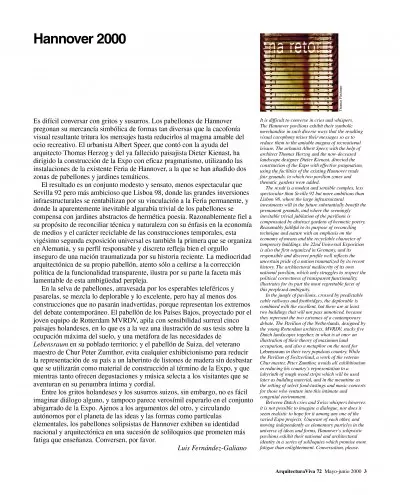Synopses
Hannover 2000. Both conventional and practical, Hannover 2000 was built on this urban site with the purpose of expanding and improving the German city’s existing trade fair grounds, which are considered some of the most important in Europe. Even so, the principal innovation presented by this exposition on its way toward the new millennium is that it seems to have broken with the century-old tradition of constructing memorable buildings: mediatic scenography has ended up surpassing the architecture of the pavilions.
Contents
Manuel Cuadra
An Urban Mirror
The Fair Grounds and the Expo,
German Virtues and Frailties
Kaye Geipel
Universal Dilemmas
Pavillions Architecture,
Tectonics and Multimedia
Buildings: Projects and Realizations
Memorable Images. Facing the multimedia invasion, Switzerland, Japan, Spain and Portugal have chosen to represent themselves with singular constructions built with natural materials such as wood, paper or cork. Architecture
Peter Zumthor, Switzerland
Shigeru Ban, Japan
Cruz & Ortiz, Spain
Siza / Souto, PortugalNational Colors. The exaltation of each country’s own architectural essences unites an avant-garde Holland with a colorful Mexico, as well as an expressionistic and organic Hungary with an ecologically conscious Finland. MVRDV, Holland
Legorreta, Mexico
Vádasz & Társai, Hungary
SARC, FinlandMotives and Themes. Wooden umbrellas sum up the green motto of the Expo; Christian faith is incarnated through geometry; and futuristic themes such as mobility, work or health are displayed within virtual settings.
Thomas Herzog, Roof Structure
GMP, Christian Church
Jean Nouvel, Mobility / Work
Toyo Ito, Health Futures
Books, Exhibitions, Personalities
From Berlin to Venice. In the Berlin Neues Museum, an exhibit covers one hundred years of the city’s urbanism and architecture; and at the Venice Biennale, Spanish representation relies on its youngest generations. Art / Culture
María Ocón
Berlín 1900-2000
Adela García-Herrera
Spain at the BiennaleIn memoriam. The disappearances of Spaniards Enric Miralles and Francisco Javier Sáenz de Oíza, key figures in the latter half of this century, are added to those of American John Hejduk and Uruguayan Eladio Dieste. Luis Fernández-Galiano
Farewell Ceremonies
Eight Testimonies
Miralles, Hejduk, Oíza, DiesteWays of Seeing. Art and life come together in the texts of John Berger, who besides re-editing one of his fundamental works has recently published the correspondence he maintained with painter John Christie.
Focho’s Cartoon
Dominique Perrault
Various Authors
Books
Interiors, Design, Construction
Immaterial France. Reflections and transparencies continue to characterize the latest in French architecture, as manifested by the mirrored facade of Dominique Perrault for an adhesive industry; the terraced facade of Patrick Berger to accommodate the UEFA headquarters; or the transparent bowl of Philippe Chaix & Jean-Paul Morel to protect a football field. Technique / Style
Dominique Perrault
Aplix Factory, Le Cellier
Patrick Berger
UEFA Headquarters, Nyon
Chaix & Morel
Licorne Stadium, AmiensTo close, the Costa Rican architect based in Houston, Carlos Jiménez, who will form part of the Pritzker Prize jury in its next edition, reports on this year’s awarding of the prize to Rem Koolhaas, at a ceremony celebrated in Jerusalem – a sacred millennium city which was not quite the best soundbox for amplifying the globalizing discourse of the Dutch winner. Products
Surface Materials
English Summary
Hannover 2000
Carlos Jiménez
Report from Jerusalem
Luis Fernández-Galiano
Hannover 2000
It is difficult to converse in cries and whispers. The Hannover pavilions exhibit their symbolic merchandise in such diverse ways that the resulting visual cacophony mixes their messages so as to reduce them to the amiable magma of recreational leisure. The urbanist Albert Speer with the help of architect Thomas Herzog and the now-deceased landscape designer Dieter Kienast, directed the construction of the Expo with effective pragmatism, using the facilities of the existing Hannover trade fair grounds, to which two pavilion zones and thematic gardens were added.
The result is a modest and sensible complex, less spectacular than Seville 92 but more ambitious than Lisbon 98, where the large infrastructural investments will in the future substantially benefit the permanent grounds, and where the seemingly inevitable trivial jubilation of the pavilions is compensated by abstract gardens of hermetic poetry. Reasonably faithful to its purpose of reconciling technique and nature with an emphasis on the economy of means and the recyclable character of temporary buildings, the 22nd Universal Exposition is also the first organized in Germany, and its responsible and discreet profile well reflects the uncertain pride of a nation traumatized by its recent history. The architectural mediocrity of its own national pavilion, which only struggles to respect the political correctness of transparent functionality, illustrates for its part the most regrettable facet of this perplexed ambiguity.
In the jungle of pavilions, crossed by predictable cable railways and footbridges, the deplorable is combined with the excellent, but there are at least two buildings that will not pass unnoticed, because they represent the two extremes of a contemporary debate. The Pavilion of the Netherlands, designed by the young Rotterdam architects MVRDV, stacks five Dutch landscapes together in what is at once an illustration of their theory of maximum land occupation, and also a metaphor on the need for Lebensraurn in their very populous country. While the Pavilion of Switzerland, a work of the veteran Chur master Peter Zumthor avoids all exhibitionism in reducing his country’s representation to a labyrinth of rough wood strips which will be used later as building material, and in the meantime as the setting of select food-tastings and music concerts for those who venture into this intimate and congenial environment.
Between Dutch cries and Swiss whispers, however, it is not possible to imagine a dialogue, nor does it seem realistic to hope for it among any one of the varied Expo projects. Unaware of each other and moving independently as elementary particles in the universe of ideas and forms, Hannover’s solipsistic pavilions exhibit their national and architectural identity in a series of soliloquies which promise more fatigue than enlightenment. Conversation, please.
Virtual Constructions and Sustainable Urbanism








